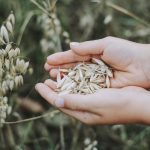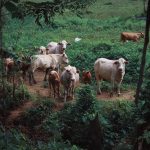
PRECISION LIVESTOCK FARMING
Introduction
Livestock farms, in order to cope with the continuous increase in demand for their products, associated with population growth, are constantly increasing their size and the productive performances of the animals. This situation places greater demands on farmers and even on the animals themselves. The objectives are to maintain a good state of health of the livestock, with a good quality of the final product. In order to guarantee all these elements, the animals have to be observed very carefully, ensuring correct feeding and reacting in time to the development of pathologies of any kind. The main drawback lies in the number of animals, which makes this observation very difficult. For this reason, the introduction of new technologies is a key tool, as they save the farmer from carrying out unnecessary tasks or heavy work, helping to manage herds and to detect any type of anomaly earlier. Initially it may seem that the investment is somewhat high, but the impact of their use on daily work, animal health and productivity must be taken into account, with the consequent reduction in costs resulting from more efficient management.
Animal welfare has also become a necessary tool to improve livestock efficiency and competitiveness, and progress in animal welfare is closely linked to the application of these new technologies. At present there is no universal, scientifically based definition of animal welfare, but there are certain general criteria by which it is established that animals should be free from: hunger, thirst and malnutrition, fear and distress, physical and thermal suffering, pain, disease and injury and from displaying normal behaviour. These criteria are set out below:
Prevent or reduce stress through strict controls on animal hygiene, the quality of the feed they receive and the environmental conditions in which they are kept.
Optimise the nutrition of the animals, so as to improve their immune status and avoid abrupt changes in feeding conditions.
Eradicate, as far as possible, certain diseases.
Genetically select disease resistant animals.
Precision livestock farming
The term used to refer to the application of new technologies to the world of livestock farming is precision livestock farming. It is understood, therefore, as a management methodology based on the use of certain sensors and other information technologies, which make it possible to monitor and optimise the contribution of each individual animal to production, health and environmental impact, among others. This monitoring involves the measurement of various biometric indicators, both physiological and morphological. In this way, visual and auditory observation by the farmer will be supported by cameras and microphones, which will carry out a continuous data collection in real time and a highly accurate assessment. This information is then processed by computer. The fact that it is in real time allows decisions to be made quickly, which can prevent the worsening of a problem or even its appearance. In short, a distinction can be made between four phases in this process. Firstly, it starts with the capture and digitisation of data, which can come from sensors such as drones or satellite images or from the manual uploading of data captured by the farmer in the traditional way. The next step is the coding and processing of the collected data, as it needs to be converted into a format that can provide information of interest, such as through the generation of maps. Thirdly, solutions to the observed variables are sought through the implementation of analysis techniques and tools in order to improve the farmer’s decision-making process. Finally, there is the implementation of all the measures linked to the application of the prescriptions of the previous step. All of this results in a production scheme that leads to an increase in yields, without resorting to overexploitation or overuse of inputs and production resources, by optimising the use of the resources available in the environment in which the activities are carried out.
The strength of these techniques lies in the fact that data are collected on site, but can be sent to other locations for analysis, which may not coincide with the area where the farm is located. This is thanks to communication via mobile phones and the internet, which are becoming more powerful, cheaper and more widely available. This last factor is of great importance, as all those farms that are further away from urban centres can now have coverage at some point. The information generated is available on the internet, where it is stored or can be presented in a simple and more visual way, making it available to the farmer at the same time as things are happening.
The aim of all this is not, under any circumstances, to replace the farmer, but to provide him with support tools for animal management, i.e., from an economic and technological point of view, the aim is to increase the profitability, efficiency and sustainability of the farms.
Most of the problems arise as a consequence of certain management guidelines or circumstances, which are not being adapted to the conditions of the animals. Some of these causes, such as stress, are predictable and can be controlled and eliminated or at least minimised. Stress is understood as a stimulus that triggers a biological response, as a consequence of an individual’s feeling of threat to its homeostasis. Within stress, a distinction can be made between different phases: the sympathetic alarm phase, the resistance phase and the exhaustion phase. It can be established that the absence or presence of stress is a major potential indicator of animal welfare. Over time, different species have developed certain types of physiological and behavioural mechanisms to cope with stressful situations, i.e. stressors. Stressors can be physical or psychological. When the stimulus that triggers the stress response disappears completely, the response that was triggered ceases and the individual returns to the original equilibrium (acute or transient stress). If, on the other hand, the stressor does not disappear and is maintained over time, the individual will tend to establish a new equilibrium, which can be beneficial but also very harmful (chronic or long-lasting stress). Animals are naturally in a state of alertness that ensures their survival in the natural environment, i.e. it is an innate attitude. In livestock, stressors can be divided into physical factors, social factors and management practices. Among the factors, the following could be highlighted:
Environmental: changes in temperature, prolonged rainfall, strong winds…
Living conditions: state of the facilities, dark environments, feed and water troughs with little capacity to meet the animals’ needs…
Management: transport, vaccination, administration of some other type of treatment, milking, among others.
Nutrition: both starvation and overfeeding, changes in nutrition, water status… can and do affect livestock.
Diseases: different types of diseases (viral, bacterial, parasitic).
All these factors are additive, i.e. if several of them occur at the same time the stress response will be greater than if the animal were exposed to only one of them. In addition to the importance that should be given to situations that may cause stress in relation to animal welfare, it is necessary to take into account that it also has negative consequences in terms of profitability and economic viability. The effects of stressful situations can lead, for example, to changes in the immune system resulting in increased susceptibility to disease, reduced fertility or reduced feed intake, which will considerably affect production as well as meat quality.
An example of the use of this methodology, documented in several studies, is related to the development of pathologies in recently calved cows, preceded, in most cases, by non-specific symptoms, which may occur five to ten days before the onset of the clinical symptoms of the disease. Some of these symptoms, which can be measured with precision sensors, are an increase or decrease in body temperature, above or below values considered normal; changes in milk composition; weight gain or loss; decreased physical activity; and changes in feeding behaviour. The point is that what is important is not only the observation of all these elements per se, but what to do when they occur. The best thing to do is to make an inventory of all the predisposing factors in order to correct them.
In recent years, progress in precision livestock farming has come about as a result of advances in the power of computer processors and the availability of new sectors, which as a rule have not been created for this sector, but which can be adapted relatively easily. In addition, there has been an increasing integration of all elements on the farms, avoiding any disruption to the normal activities to be carried out. In addition, the need for human intervention in data acquisition and transfer to the system has been reduced. Some of the recently developed systems are presented below:
Intelligent control of ventilation in animal housing.
Estimation of animal weight, through the application of image analysis techniques.
Livestock monitoring systems, through the use of drones and satellite images or through the distribution of cameras.
Improvement of hatchery performance through the synchronisation of hatches.
Inspection of broiler carcasses.
Automatic egg counting and identification.
Improved thermal control of pigs through computer vision.
Interpretation of sounds in pigs, captured by microphones and cameras.
Monitoring in relation to udder health in dairy cows.
The following publication will study in depth the use of drones in precision livestock farming, mainly associated with extensive livestock farming, used both in the control of pathologies, through the use of thermographic cameras or in the search for lost animals, among others.






